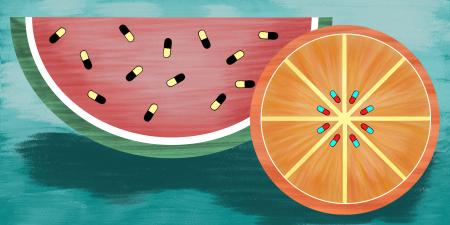Abstract
In this case, a physician wonders what he should do to help make nutrient-dense foods available in underserved neighborhoods. I argue that improving diets of people who live in food deserts is a complex problem at the intersection of culture, education, and economics that will require community partnerships and clinician self-education to solve.
Case
At a community meeting, Dr D presented his research on physician attitudes toward and work habits in food deserts and the obstacles that prevent physicians from promoting nutritious diets to patients with low income. Dr D found that physicians have limited training in foods, nutrition, and behavior change counseling, all of which are poorly reimbursed by insurance companies and Medicaid. At the end of the presentation, a local advocate for community services who wanted to eliminate food deserts by building full-service grocery stores asked, “In this day of limited availability of healthy foods and not enough resources to buy them, shouldn’t insurance companies, food banks, and physicians do more to ensure that nutritious food is available in our underserved communities?”
On the way home that evening, Dr D thought about differences in foods available in the communities where he lived and worked. Near his home, there were 3 large, brightly-lit stores with the word “fresh” as a part of their name. These stores were well stocked with an array of produce, whole-grain breads and cereals, freshly prepared foods, and even junk food items cleverly packaged to appear nutritious. They stood in sharp contrast to nameless stores with security gate entrances near the medical center where he worked. In these small stores, aisles were crowded with sugar-sweetened beverages, high-fat sugary snacks, high-sodium convenience foods, and the occasional bunch of overripe fruit or limp vegetables. Given that markets typically reflect consumer demand, Dr D began to think that food availability might be one facet of a more complex problem. Did his patients know what they should eat?
As Dr D thought about the patients in his practice, he recalled early attempts to improve his patients’ knowledge—and ultimately their consumption—of nutritious foods. Dr D came to realize, however, that counseling patients was impractical because counseling must be continued for months to achieve positive behavior changes. Extending appointments to provide counseling decreased the number of patients he could see, impairing his productivity and ultimately the revenue he contributed to his group practice. Besides, many of his patients had deferred medical care of equal if not greater priority than dietary changes. Most of his patients worked more than one job to support their families, and few of them had resources to pursue something as ethereal as their long-term health.
Dr D also realized his own preference for a mostly Mediterranean diet differed from the diets preferred by many of his patients, some of whom were unfamiliar with or perhaps even wary of foods he recommended. Dr D wondered whether foods he consumed really were more nutritious than foods consumed by many of his patients. He came to understand that foods patients viewed as traditional—regardless of nutrient density—can be important simply because they can serve as cultural and community touchstones. As a result, Dr D has become more humble about attempting to steer patients away from some foods in case doing so might be interpreted as disrespectful of food preferences driven by cultural practices.
Dr D now wonders, Given these experiences and what I’ve learned over the years about counseling and the cultural importance of food practices, what should I as a physician do to improve availability and consumption of nutritious foods among patients in communities near the medical center?
Commentary
In this case, Dr D appears to have met his ethical duty to advance knowledge1 by sharing his research findings about physician attitudes toward and work habits in food deserts. As Dr D might suspect, however, he is likely expected to do more. In fact, the American Medical Association (AMA) Code of Medical Ethics specifies in Opinion 8.11 that physicians should promote healthy communities while balancing “a commitment to individual patients with the health of the public.”2 If improving consumption of nutritious foods would improve the health of a community, advocating for greater availability of more nutritious food would be one way to fulfill such a responsibility. To balance his commitment to individual patients with his public health duties, Dr D counsels his patients on nutritional health and also considers a suitable community health initiative.
In the Clinic
Since Dr D learned that respecting cultural traditions could enhance the patient-clinician relationship, he now resists asking about specific foods that have cultural importance even when he considered them unhealthy. In Dr D’s experience, many of his patients want to eat as well as possible. Their families are no different than families at other income levels: they also make choices every day about the convenience, quality, and taste of the foods they eat.
Dr D had implemented a “collaborative, patient-centered” approach to care of his patients to promote trust and to recognize patients’ “self-directed roles” in maintaining their health, as recommended in Opinion 8.11 of the AMA Code.2 He devised this approach in order to be respectful of patients’ cultural traditions, consistent with Opinion 1.1.3 of the AMA Code, which states that patients are entitled to respectful communications from their physicians.3 Since he had not been trained in foods and nutrition, Dr D decided, in accordance with Opinion 10.5 of the AMA Code, that he would “delegate ... to an appropriately trained and credentialed allied health professional”4 responsibility for developing or selecting a nutrition resource list for patients, providing some culturally appropriate nutrition materials that the medical assistants could distribute, and providing some training in basic meal planning for the medical assistants in his practice. After learning that many of his patients were interested in nutritious foods, Dr D contracted with a registered dietitian nutritionist (RDN) to develop this component of his practice.
The RDN might select copies of MyPlate,5 the US Department of Agriculture’s food guide, in the languages most often spoken by Dr D’s patients and train Dr D’s medical assistants to use this free resource, which includes printable material and a smart phone app. The approach taken in the training is to focus on realistic portion sizes—minimizing large amounts of energy-dense foods in favor of smaller portions of nutrient-dense, familiar foods—and avoid labeling specific foods as “good” or “bad.” Dr D might also provide incentives for his medical assistants to attend an online health coaching program to learn behavior change skills that they could apply to several health behaviors including consumption of nutritious food, smoking cessation, and exercise.
At a first in-service training for the medical assistants, the RDN would likely present a resource list that could be distributed to patients. Had Dr D and his partners reviewed it earlier, they might be surprised to learn about several previously unknown community resources and nutrition programs that were available to their patients. There were food pantries, including several that had a strong nutrition education component because they were affiliated with the foods and nutrition department at a local university. The nutrition department at the hospital where Dr D and his colleagues admitted patients offered classes on various nutrition topics as part of their commitment to the surrounding community and provided a series of classes about preparing quick, nutritious meals on a budget on their website. There was a community food bank that accepted donations from nearby restaurants and also distributed produce grown in a community garden. The mission of one of these programs was aligned with the goals of Dr D’s practice, so he might add it to a list of charitable foundations he supports. Dr D and his colleagues might also learn that the Supplemental Nutrition Assistance Program (SNAP) is accessed by many of his patients as a popular way to encourage purchasing fresh produce at nearby farmers’ markets.
In the Community
Dr D could delegate development of a nutrition component for his practice and open time in his schedule to concentrate on improving the diets of community members. Consistent with Opinion 11.1.1 in the AMA Code, he might do some reading so that he could apply best-available evidence to the health care services he provides.6 For example, Dr D might find data suggesting that people purchase the same types of foods regardless of where they shop7,8—whether in a corner store in a food desert like the one surrounding his practice or in a distant full-service grocery like the one in his neighborhood. Dr D might not favor building a full-service grocery store near his practice for other reasons. He might know that costs for building a full-service grocery store can exceed several hundred thousand dollars depending upon the business model selected.9 Some community activists might oppose full-service grocery stores because they fear negative effects of community development and gentrification. Finally, because corner stores can be viewed as a community resource and because they can be more successful in promoting nutritious foods than full-service grocery stores, Dr D might decide to help strengthen the existing business community by engaging corner store operators in an intervention to stock nutritious foods. Dr D might also know of an initiative to implement minimum stocking requirements for nutritious foods in stores that accepted SNAP and that merchants objected to these requirements because perishable items such as low-fat milk and fresh fruit were unpopular with consumers and often spoiled before they sold.10 To lessen the problem of spoilage, Dr D could encourage small store owners to stock whole grains, dried peas, dried beans, dried fruits, and nuts used in cooking traditional foods enjoyed by members of the community. He could also offer a small incentive to store owners who stop by his office to view the brief nutrition videos he offers his patients to promote consistent messaging in the community around these products.
A Way Forward
Improving the diets of people who live in food deserts is a complicated problem at the intersection of culture, education, and economics. Dr D will clearly need to collaborate with his patients and with leaders in the community to improve the availability and intake of nutritious foods. He should continue to learn more about making nutritious foods available in order to support initiatives based on scientific evidence and follow the opinions in the AMA Code, which provide a great deal of guidance related to this complicated problem.
References
-
World Medical Association. WMA Declaration of Helsinki—ethical principles for medical research involving human subjects. https://www.wma.net/policies-post/wma-declaration-of-helsinki-ethical-principles-for-medical-research-involving-human-subjects/. Adopted June 1964. Accessed March 30, 2018.
-
American Medical Association. Opinion 8.11 Health promotion and preventive care. Code of Medical Ethics. https://www.ama-assn.org/delivering-care/health-promotion-and-preventive-care. Accessed April 30, 2018
-
American Medical Association. Opinion 1.1.3 Patient rights. Code of Medical Ethics. https://www.ama-assn.org/delivering-care/patient-rights. Accessed July 20, 2018.
-
American Medical Association. Opinion 10.5 Allied health professionals. Code of Medical Ethics. https://www.ama-assn.org/delivering-care/allied-health-professionals. Accessed April, 30 2018.
-
United States Department of Agriculture. Choose MyPlate. https://www.choosemyplate.gov/myplate. Accessed July 20, 2018.
-
American Medical Association. Opinion 11.1.1 Defining basic health care. Code of Medical Ethics. https://www.ama-assn.org/delivering-care/defining-basic-health-care. Accessed July 20, 2018.
- Walker RE, Keane CR, Burke JG. Disparities and access to healthy food in the United States: a review of food deserts literature. Health Place. 2010;16(5):876-884.
- Vaughan CA, Cohen DA, Ghosh-Dastidar M, Hunter GP, Dubowitz T. Where do food desert residents buy most of their junk food? Supermarkets. Public Health Nutr. 2017;20(14):2608-2616.
-
Save-A-Lot Food Stores. Estimated start-up costs. https://save-a-lot.com/own/become-an-owner/estimated-start-up-costs.html. Accessed August 1, 2018.
-
Karpyn A, DeWeese RS, Pelletier JA, et al. Examining the feasibility of healthy minimum stocking standards for small food stores [published online ahead of print, April 9, 2018]. J Acad Nutr Diet. doi:10.1016/j.jand.2017.12.006.



